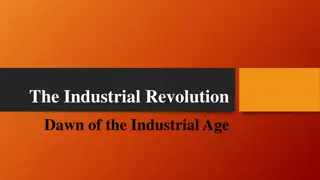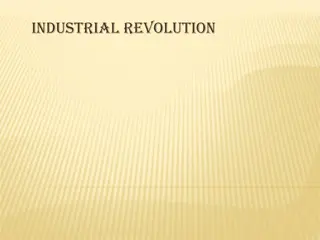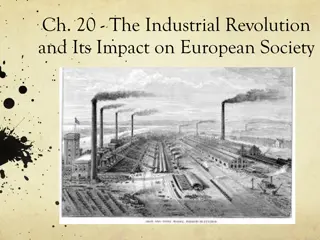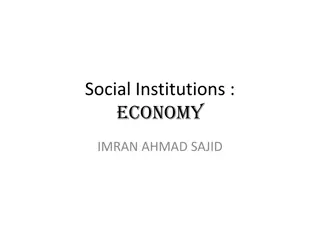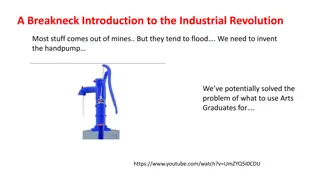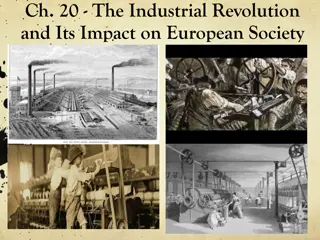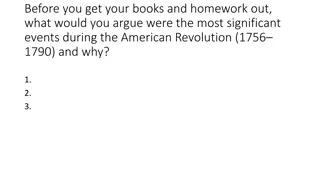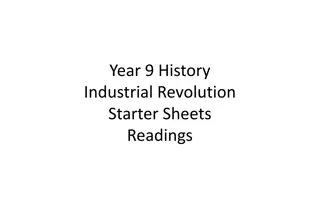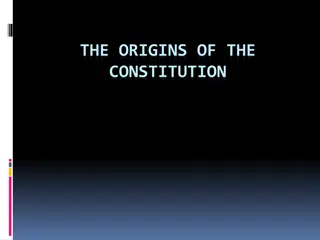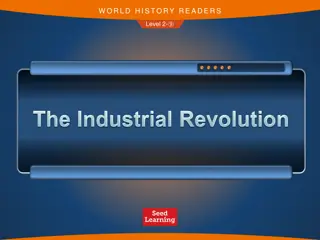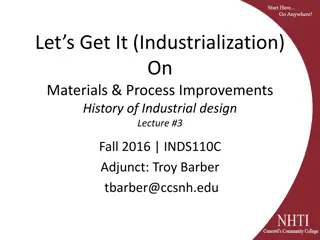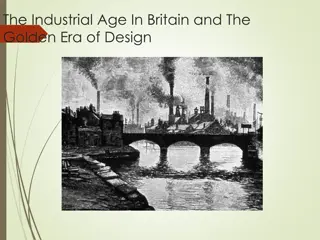Impact of the Industrial Revolution on Society and Ideals
The Industrial Revolution, spanning from 1760 to the late 1800s, revolutionized manufacturing, leading to improved living standards in the developed world. Mechanization, new energy sources, steam engines, and railways transformed production and transportation, fostering innovation. Despite the French and American Revolutions' ideals falling short, the Industrial Revolution made material wealth and freedom accessible to more people, bridging the gap between social classes.
Download Presentation

Please find below an Image/Link to download the presentation.
The content on the website is provided AS IS for your information and personal use only. It may not be sold, licensed, or shared on other websites without obtaining consent from the author.If you encounter any issues during the download, it is possible that the publisher has removed the file from their server.
You are allowed to download the files provided on this website for personal or commercial use, subject to the condition that they are used lawfully. All files are the property of their respective owners.
The content on the website is provided AS IS for your information and personal use only. It may not be sold, licensed, or shared on other websites without obtaining consent from the author.
E N D
Presentation Transcript
The Industrial Revolution was a long series of changes in the manufacturing and distribution of consumer goods starting around 1760 and continuing into the late 1800s, which resulted in an unprecedented rise in the standard of living for people in what we now call the developed world.
The mechanization and application of new sources of energy to manufacturing. Previously most goods were made by hand. The assembly line model and mass production made possible by the invention of machines that aided in manufacturing. Mechanization in turn was made possible by the harnessing of new sources of energy:
The steam engine made coal cheaper, which in turn made steam power cheaper This led to railroads, which made the transportation of consumer goods cheaper This increased demand, which spurred more production and innovation Aided by faster communication, each innovation fostered new innovations Better technology led to new scientific discoveries, which made possible newer technologies.
French Revolution (1789) Liberty, Equality, Fraternity American Revolution (1776) All men are created equal and possess the inalienable right to Life, Liberty and the Pursuit of Happiness Both failed to realize their ideals.
The realization of these ideals only became possible through the Industrial Revolution. Because of the Industrial Revolution, everyone in the developed world now has access to the material wealth and freedom that were previously the privilege of a tiny minority. This is not yet true for the developing nations, but even there conditions are improving.
Industrial rather than agrarian economy. Population became concentrated in cities. Children knew more than their parents. Meritocracy replaced aristocracy. People become exposed to new and foreign ideas. Change became the norm and the future became an open range of possibilities. SF is the offspring of the Industrial Revolution.
Roman de la Scienceor scientific romance Influenced by travel writing and Robinsinades. charming romance intermingled with scientific fact and prophetic vision.
Both were done by Americans. Both were launched from Florida. Both used the same technology as weapons of mass destruction.
We construct arguments to support claims that are contentious, controversial, or that there is some dispute about. A good thesis is: Clear Specific Contains only one claim NOT obviously true NOT subjective
A thesis (or conclusion) is supported by reasons (or premises). A reason is information that makes your thesis more likely to be true. Reasons must also be supported (with other reasons), unless: It is common knowledge or obviously true. It is a citation from an authoritative source. It comes from a primary source, e.g. a passage from the text that your argument is about.



